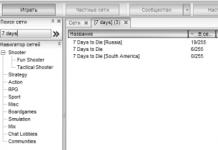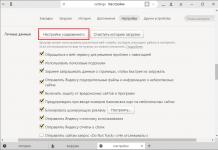Setting an access password is the basis of any security system. If more than one person has access to the desktop, questions arise about protecting personal life, business information, and protecting system settings from unwanted interference.
So, how to set a password on your computer? Depending on the operating system, modifications to the motherboard, there may even be several passwords at different levels of entry to the computer.
Setting a password on Windows XP, Windows 7, 8 and 10
Let's say this is the situation. The computer is used by several people, including small children or simply irresponsible individuals. Then not only personal data, but also all installed programs need protection.
You wouldn’t want to find yourself in a situation where you urgently need to print a document, you start your PC, and someone has deleted your favorite word processor. A new installation will take precious time.
Or the opposite situation. In addition to you, the computer is used by someone who likes to experiment with downloading and installing new programs from the Internet. What are the consequences of such a hobby?
You can catch a serious virus, a ransomware banner, and even completely destroy the operating system. To protect against all these accidents, users of the same desktop are assigned different accounts and different levels of system control.
For example, the Administrator has the rights to do absolutely everything on the computer. Less authorized users are assigned lower-level rights, from which they can only use a certain set of programs and their documents. Such a user cannot change anything in the system.
Assigning User Accounts
- Click Start
- Find Control Panel
- Go to User Accounts
- Create or change an account and give it a password
If you are responsible for the computer, assign rights to each partner according to the level of his computer literacy and mental maturity.
Windows 10 now has another way to change your password. You need to open “Start”, then “Settings”, then “Accounts”. If you already have an account, but it does not have a password, you can add a password on the “Login Options” tab. You can also change your old password to a new one.

What to do if your password is lost?
There are several options:
- Completely reinstall the operating system. This is the last resort.
- You can simply log into the system in safe mode and reconfigure everything. To do this, press the F8 button before starting to boot the computer. A menu of login methods will open. Select a secure login. Next, according to the previous algorithm, set up scientific records and set a new password.
BIOS
Even more powerful security protection. The computer will request a password even before the operating system starts loading. No newcomer will be able to get inside here anymore.
There is nothing complicated about installing on the BIOS either. As the computer starts to boot, press Del or F2 several times and the BIOS settings will open. Find the Security or BIOS Setting Password item – this may vary depending on the system.

Now set the password and save the new settings with the F10 button. What to do if you have lost your password to enter the BIOS? This issue can be resolved even more simply. Disconnect the computer from the electrical outlet, open the system unit and remove the small battery on the motherboard for a while. As a result, the Bios installation will return to factory settings.
How to set a password on a mobile computer
What if you want to protect your Android tablet from prying eyes? There is nothing complicated here either.
- Tap your finger on the gear sign and you will be taken to Settings.
- Look down point by point. Seek Security. Enter Security Settings.
- There you will find approximately the same settings as on Windows XP - installing scientific records, encrypting login to the device with a password.
- Follow these steps, and after that, every time you start the tablet, you will have to enter the access password.

How to reset the password on an Android device in this case? There are 2 ways:
- Enter the password incorrectly 5 times. A window will appear asking you to enter your Google account credentials. After entering them, you can recover your password. If you don’t even know this data, then you’ll have to take the second path.
- You will have to do a complete rollback of the entire system to factory settings. Read the description in the article
Don't be afraid that after reinstalling the system, all your favorite applications will disappear. Sign in to your Google account and the system will automatically tell you which apps have been installed on Google Play. The truth is that it will be costly for your Internet traffic.
How to set a password on iPad
- Open Computer Settings.
- Find the item Basic - General.
- Select PasscodeLock.
- Now assign a password.
- Turn the password into action – Turn Passcode On. And don't forget to remember or write down your new password!
Greetings, friends. will be the topic of our today's episode. This article can also be applied if you were looking for information how to put a password on a computer.
Surely each of you has thought about the issue of protecting your information. So, now we will set a password on our computer in two operating systems, Windows XP and Window 7. In the last issue, I talked about.
Set a password
If you work in an office or similar place where there are a lot of computers and people, then there is probably important and valuable information there. There are several ways to protect it, one of them is to set a password for the desired file, document, folder, or for the entire computer as a whole.
In this article we will look in detail at all the details of how to quickly and correctly set a password on a computer. Perhaps in the future I will publish information on how to set a password for a specific file or folder.
There are people who know how to set a password on a computer, but there are also those who do not know it. I decided to publish this article especially for them. Not everyone likes to read; for some, it is easier or more enjoyable to absorb material in video format. For those, I posted two video lessons on how to do this.
If you want to protect your computer from viruses, I recommend installing a good antivirus, for example.
Well, let's start setting a password on the computer.
How to set a password on a computer in Windows XP
This is a simple procedure that anyone can do using these recommendations.
As usual, the first thing, of course, is to turn on our computer. Go to the Start menu.

Go to the Control Panel. Find User Accounts.

All users who are on this computer appear in front of us. In my case, there are two of them, User and Guest, but there is also a third Administrator account, which can be hidden, keep this in mind.

Here you can change your account, create a new one, and change user logins.

In order to set a password, you need to select the desired account under which you work on this computer and simply click on it.

In this example I go to User, yours may be something different. For example User, your name or any other name. In the next window we have the option to change the name, create a password, change the image, change the account type and more.


We go to the Create a password for your account tab. If you cannot think of a password, then use the training tips - Create a secure password.

Here you need to enter a new password and confirm it.

There is an option to create a password hint, which you can use if you suddenly lose or forget your password.

After you have come up with a password and entered it into the password confirmation, you need to click on the Create password button.

In the next window we will be asked to make our files and folders personal. If you do not want other people who use this computer to have access to your documents, then you can block access to them. To do this, click Yes, make them private.

If you want to remove the password, then you must also go to user accounts, select the desired account and click on the remove password tab.

Well, that’s basically the whole simple procedure for setting a password for your computer in the Windows XP operating system. I also recommend watching a short video lesson. If you have forgotten, lost, or simply cannot remember your computer password, you can use the article.
How to set a password on a Windows XP computer
Creating a password in Windows 7
This instruction is almost no different from how to set a password on Windows XP, the only thing is that the interface (appearance) is slightly different.
Go to Start >>> Control Panel.

Go to User Accounts and Family Safety.

Click on User Accounts or Change Windows Password.

Go to Create your account password.

We write a new password and confirm it.

You can also write a password hint.

In order to change your password, you need to click on Change your password.

If you want to remove your password, go to Remove your password.

Well, it’s not difficult, really, you just need to know where to go and what to change.
How to set a password on a Windows 7 computer
A few words in conclusion
Today I showed you how to set a password on a computer in two operating systems: Windows XP and Windows 7. I advise you to set strong passwords to protect your information.
Perhaps you have or have any questions related to setting a password on your computer, you can ask them below in the comments to this article, or also use the form with me.
Thank you for reading me on
If you want to protect your data from strangers, then you can set a password on your computer when logging into your account. In this article we will talk about how this is done in the operating systems Windows 10, Windows 8, Windows 7 and Windows XP.
How to set a computer password when logging in on Windows 10 or 8
In order to or Windows 8 you need to go to the “Options” menu. In Windows, all you have to do is open the Start menu and select Settings. In Windows 8, options can be accessed through the right side menu.
Once you have opened the Settings menu, go to the Accounts section, and then to the Sign-in Options subsection. Here you can set a password on your computer; to do this, click on the “Add password” button.

And enter the new password twice, as well as a password hint.

After this, a password will be set and you will not be able to log into your account without it.
How to set a password on your computer when you log in to Windows 7
To set a password on a computer running Windows 7, you need to go to the Control Panel. To do this, click on the “Start” button and select “Control Panel” on the right side of the menu.

After opening the Control Panel, go to the User Accounts and Family Safety section, and then to the User Accounts subsection. As a result, a window with your account settings should open in front of you. If you want to set a password to log in to your account, then click on the “Create a password for your account” link. If you want to set a password for another user, then click on “Manage another account” and select the user you need. But keep in mind that you will need administrator rights to do this.


After that . Now, when you try to log in to this account, you will be prompted to enter a password.
How to set a password on your computer when you log in to Windows XP
If you are using the Windows XP operating system, then in order to set a password on your computer you need to go to the “Control Panel”. To do this, simply click on the “Start” button and select “Control Panel” from the menu that opens.

After logging into the “Control Panel”, you need to open the “User Accounts” section.

Next, select the account for which you would like to set a password on your computer when logging in. Please note that you can always set a password for your account. But, in order to set a password for other accounts, you need to have administrator rights.

Once you have selected an account, click on the “Create a password” link.

The last step is filling out the form. Here you need to specify twice the password you want to set on your computer when you log in, as well as a password hint. After filling out all the fields, click on the “Create password” button.

That's all, now when you log into your computer using your account, you will see a password prompt.
To protect your computer from unwanted users, it is better to take care of creating a strong and complex password that you must enter every time you log in. This is especially effective when you need to restrict access to children, curious friends or colleagues on your work computer. In Windows, there are two options for setting a password on your computer: one of them is simpler and faster, and the other involves installing a code in the BIOS, which in itself is difficult if you are an inexperienced user. Try to understand both methods and choose the one that suits you best, or install two codes at once for greater system reliability.
How to password protect a computer: the standard method
This option is perfect if you are protecting your personal computer from ordinary users who will not bother with password reset methods. In addition, you will always have a small hint available to you in case you forget the code. Other accounts on the computer will lose access to your personal folder and will not be able to view your documents, photos and other files.
- Go to the Start menu and then to “Control Panel”.
- Sort by category in the upper right corner of the screen. This will make it easier for you to find the item you need. Click on the line “User Accounts and Family Safety”.


- In the window that opens, click on “User Accounts”.


- You will now see your account settings. If you need to set a password for it, then click “Create a password for your account,” and if for another user’s account, then “Manage another account.”


- Enter a password twice that you will not forget and no one will guess about it. At the bottom you can find a field to enter a hint. Enter a word there that will make you think of a password.


- You can change your password at any time by clicking on the “Change your password” item.


How to password protect a computer through BIOS
You will need this method if you need to protect your network from a skillful teenager who has already reset your Windows password more than once. Try setting the code in the BIOS.
- To do this, you need to carefully read the instructions on the screen while the operating system boots.
- As a rule, you enter the BIOS by pressing F7 or F11, but these buttons differ on all computers.
- After entering the BIOS, find the “Set User Password” item and enter the code.
- Restart your computer.
This password cannot be reset without switches on the motherboard. Your computer is now securely protected. Don't forget it under any circumstances.


How to temporarily password protect your computer
There is another method that allows accounts to use the computer temporarily and then blocks access. This is very convenient for restraining children.
- Go to Control Panel, and then to the “User Accounts and Family Safety” section.
- Enter the “Parental Control” subsection.


- Here you can manage a particular account, for example, a guest account.


- Switch the checkbox to the “Enable using current settings” line.


- Select the setting you want to block. For now, consider the “Time Limit” item.


- You are offered a convenient schedule. Mark with blue marks those hours when you can use the computer without a password.


- Once the schedule is set, click “Ok”.


- You can also select the programs that you can use.
- This type of parental control gives you confidence in your child if he or she uses the computer too often.


One of the main tasks of every PC user is to protect his computer from third-party interference. You probably won't like it if someone else gets access to the files stored on your PC, so if you still don't know how to put a password on a computer, It's time to correct the situation and expand your knowledge in the field of protecting your data from prying eyes and hands.
Of course, setting a password does not guarantee that no one will be able to use your computer. Unfortunately, any protection can be hacked if necessary, and if someone seriously decides to gain access to your PC, they will achieve their goal. However, it is unlikely that such important data is stored on your device that all the hackers in the world will try to gain access to it, and most likely you are thinking about how to set a password on your computer in order to limit access to the PC for some family members who probably do not have the knowledge. necessary to crack the password.
In this article we will look at two ways to set a password on a computer - through the operating system Windows and through BIOS. The second option is universal and does not differ depending on the operating system installed on your computer, but the first has some differences, so we will separately look at how to set a password on a computer with Windows 7, Windows 8 and Windows XP. In essence, this is basic knowledge, but many users have many questions about this, so step-by-step instructions with corresponding pictures will be given below.
How to set a password on a computer in Windows
As mentioned earlier, the process of setting a password using Windows involves some differences depending on the version of the operating system used, and therefore we have prepared separate instructions for Windows 7, Windows 8 and Windows XP.
Setting a password in Windows 7.
Let's go to "Start - Control Panel".

In the window that opens, change View from "Category" on "Small Icons", if this has not been done previously.


Now you need to come up with an account password, which we will subsequently use to turn on the computer. The password must be entered twice. In addition, you are required to enter a password hint, which will be needed to recover it if you forget it. After filling in all fields, click on the button "Create a password".

Your computer is now password protected and will require you to enter your password each time you start and exit sleep mode.
How to set a password on a computer in Windows 8.
First you need to open the menu windows 8. To do this, move the mouse cursor to the very top right screen of the monitor. In the menu that appears, select a section "Options".

After this, an additional Windows 8 menu will open, where you need to select a partition "Change computer settings". Further in the section "PC Settings" select item "Users", then click on the button "Create a password". In the page that opens, opposite the line "New Password" enter the desired password, which must be repeated in the line "Please re-enter your password". In line "Password Hint" provide information that, if you are unable to log in using your password, will help you recover it.

For the changes to take effect, click on the button "Further". After this, a page will open with a notification about the successfully created password. Click on the button "Ready" and the next time you turn on the system you will be prompted to enter a password.
How to set a password on a computer in Windows XP.
1. Open the menu "Start" and select "Control Panel".

2. In the window that opens, select "User accounts". There may be some differences depending on the selected display mode; we have provided screenshots for both options.


3. In the window that opens, select your account. If you did not specify a user name during the installation of Windows and during its subsequent use, then the name should be used "Admin", which sets the default for all computers.

4. In the account management window, click on the section "Create a password."

5. Next, you must enter the desired password twice in the appropriate fields. The system will also ask you to enter a hint to recover your password. You can fill out this field or enter nothing, it all depends on your personal preferences and this field is not mandatory.

6. After filling in all the required fields, click on the button "Create a password". Now the system will prompt you to make your files and documents hidden from other users. In this case, there is also the opportunity to refuse, so when making a decision, it is based on personal wishes. That's all, the password setting has been completed successfully, which you can do by restarting your computer.
How to set a password on a computer in the BIOS
It should be said right away that setting an account password using the operating system involves a much simpler procedure than a similar process through the BIOS. However, before you put a password on your computer in Windows, you should consider the BIOS option. The fact is that a password set in this way is much more secure and cannot be cracked programmatically. To make the necessary settings, you need to enter directly into the BIOS itself. This is done by pressing a specific key when turning on the computer. Depending on the computer model, the key will differ, the most commonly used "Delete". You can clarify this question by using the Internet or documents that came with your computer. After you find out which key is used to enter the BIOS, you can begin setting a password.
It should be noted that the BIOS versions also differ, so there may be differences in the menu items and it will not be possible to provide universal instructions. For example, in some versions the password is set in the section "BIOS Setting Password", when you click on it, you will be prompted to enter a password. True, this password will only be requested when entering the BIOS; we need to make sure that the need to enter the password arises when loading the operating system. To do this you need to find the section "Advanced BIOS Features", and opposite the point "Password Check" set value "Always".
In another BIOS version, the password is set in the section "Password on boot", opposite which you need to set the values "Enabled"


























